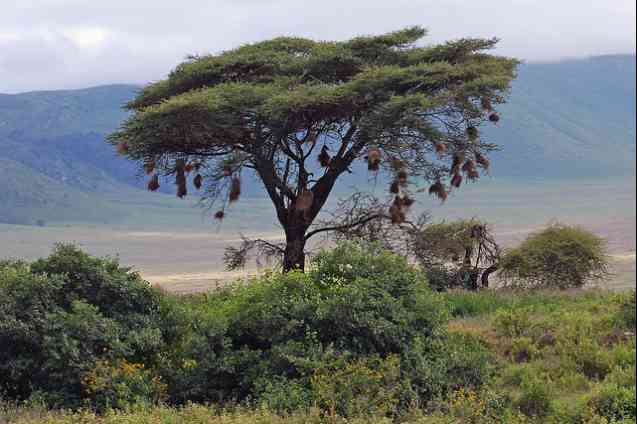Africa’s Little Five
While the Big Five are on the top of many people's safari bucket lists, they are by no means the only wondrous creatures that call Africa home. We have a plethora of other animals, birds and beetles to delight visitors.
Not least of these are our 'Little Five': the elephant shrew, ant lion, buffalo weaver and rhinocerous beetle.
For these guys, you'll be needing to keep your eyes peeled closer to the ground!
The Elephant Shrew
 Elephant Shrew by wagon16
Elephant Shrew by wagon16
Believe it or not, these tiny cuties are really related to elephants, genetically. Also called sengis, they range in size from 10 to 30cm and weigh between 50 and 500g. There is nothing large about these li'l mouse-like characters, with their elongated noses.
Small and hairy, they have longer legs than mice and can run like the wind (and jump!) through the passages they create in the undergrowth. They use their trunk-like noses to sniff out insects for dinner.
They're shy and quick, so spotting one is very lucky.
The Ant Lion
 Ant Lion Trap by gnomeza
Ant Lion Trap by gnomeza
If you spend just ten minutes in the African bush looking down at the ground beneath your feet, you're bound to see at least one tiny ant lion trap. They're concial depressions in the sand, made by the burrowing ant lion. Unsuspecting ants fall into these 'traps' and bam! Ant lion lunch.
While it isn't clear where the name comes from, it is thought to be because of their ferocious hunting skills (of ants). The stage of this insect's life when the name applies, is its larval stage.
It is by no means pretty, with its fat body and narrow head on which its huge (in comparison to its size) jaws reside. Honestly, only its mother could love it.
 Ant Lion by Mike Keeling
Ant Lion by Mike Keeling
After its 'lion' stage, these insects undergo a metaphorphosis, hanging out in a pupa for about a month, and then emerge as rather pretty, flying adults, who no longer hunt ants but, gently feed on pollen and such! They are rarely seen, as they are only active at night.
The Buffalo Weaver
 Red-Billed Buffalo Weaver by wagon16
Red-Billed Buffalo Weaver by wagon16
These noisy birds are very sociable, and have been known to live near humans, moving if they do. They tend to live in relatively large colonies and gained their name from hanging out with buffalos - eating the insects kicked up by their large friends.
They create huge, messy nests out of twigs and grasses, each with several entrances. The nest is divided into separate compartments or rooms. The red-billed buffalo weaver is the only one found in South Africa and its white-billed and white-headed counterparts are found further up Africa.
 Buffalo Weaver Nests, Ngorongoro by Harvey Barrison
Buffalo Weaver Nests, Ngorongoro by Harvey Barrison
The Leopard Tortoise
This little guy is named thus because its shell-markings are suprisingly close to those of a leopard. That's where the similarities end, though.
 Leopard Tortoise by Bernard DUPONT
Leopard Tortoise by Bernard DUPONT
While they're part of the Little Five, Leopard Tortoises can grow up to over half a metre in diameter and have a lifespan of 50 to 100 years, making them the biggest of the Little Five and, therefore, one of the easiest to spot.
The hissing sound that sounds so unfriendly when these creatures get scared and retract into their shells? It's not actually them hissing, but rather the air being squeezed out of their lungs as they squash into their shell.
The Rhinocerous Beetle
Another one that only its mum could love, this fierce-looking beatle has a (tiny) 'bite' to match its look.
 Rhino Beetle by Bernard DUPONT
Rhino Beetle by Bernard DUPONT
Okay, we admit, it's not really a bite, it's just that the male rhino beetle uses his horn to fight epic (tiny) battles with other males, when the need arises. Like humans, these battles are usually over a cute female rhino beetle.
They're harmless to humans, despite looking like thugs!


 Briony is a qualified pharmacist, published author and travel blogger living in Cape Town. She writes her own blog about travel, the arts, music and the good things in life, with a focus on accessibility. She likes watching the world go by, and sometimes it makes her nose twitchy, but mostly it provides golden nuggets with which to light up the page.
Briony is a qualified pharmacist, published author and travel blogger living in Cape Town. She writes her own blog about travel, the arts, music and the good things in life, with a focus on accessibility. She likes watching the world go by, and sometimes it makes her nose twitchy, but mostly it provides golden nuggets with which to light up the page.



